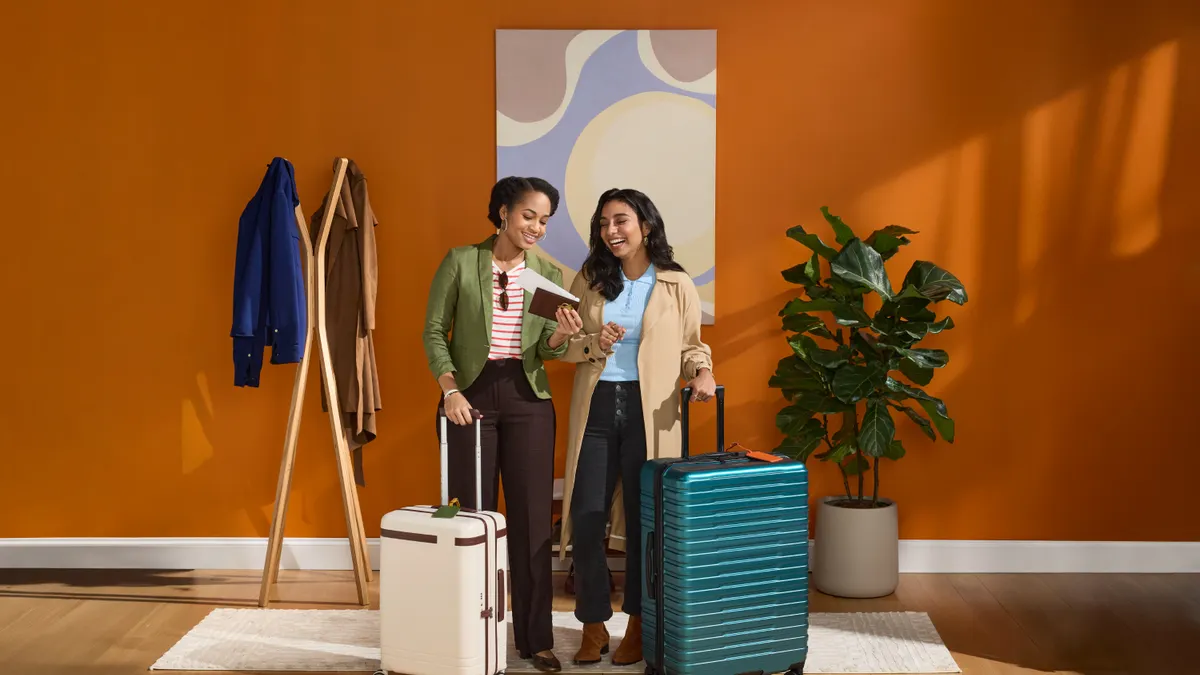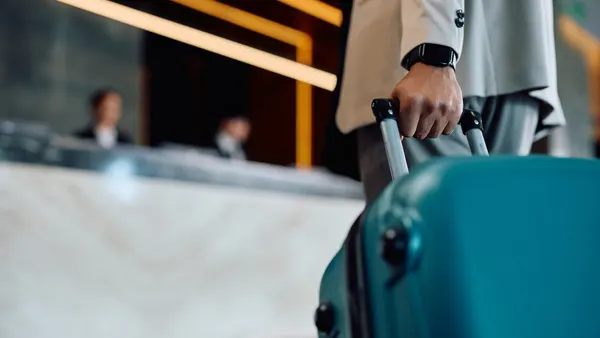Customers’ travel journeys didn’t begin with a hotel search—it started the moment wanderlust hit. Maybe it was while binge-watching a rom-com set in a New England town, or stumbling across livestreams of Japanese tea ceremonies. Today’s travelers use different entertainment and shopping channels to plan their trips from inspiration to purchase and post-trip sharing. And that journey has revenue potential extending beyond traditional hospitality touchpoints.
New research on U.S. travel spenders reveals how modern travelers dream, plan, budget, and make travel decisions—and where hospitality advertisers can connect with them meaningfully at decision moments.
The new travel journey: from inspiration to booking
Today’s travel funnel is a dynamic journey with many advertising touchpoints during the consideration phase. Nearly three in five travelers didn’t have a specific destination in mind when they first decided to take a trip, according to Expedia.[1] This ambiguity represents an opportunity to connect more deeply with travelers while they are still dreaming up their plans and are most receptive to fresh ideas.
Inspiration comes from conversations with friends and family, events, or media content—including streaming TV, social platforms, and advertising.[2] The influence of entertainment is striking: 64% of travelers were inspired to visit a destination after seeing it in a TV show, news source, or movie. For hotel marketers, the path to booking often begins with a streaming queue—not a search engine.
Understanding trends across generational groups helps advertisers tailor their approach. While travel intent is strong across age groups, travelers aged 18-29 are 1.9 times more likely to have five or more trips planned in the next six months,[3][ but planning timelines can differ dramatically. U.S. travelers typically spend 71 days researching trips, viewing 277 travel pages over 45 days leading up to their trip.[4] In contrast, Gen Z respondents were 30% more likely to spontaneously book trips two weeks in advance.[5]
This variance demands different advertising strategies. Marketers must maintain sustained visibility for both long-term planners and spontaneous bookers. Insights-rich advertising solutions that enable relevant messaging are key to connecting impactfully with travelers across varied timelines.
Translating traveler preferences into campaign strategy
Understanding modern travelers helps hotel marketers craft effective messaging and allocate budget to high-impact channels.
Today’s travelers crave authenticity and novelty. Nearly seven in ten travelers want to go somewhere “off the beaten path” and seek out lesser-known spots, with 81% of Gen Z and Millennials eager to share a new location with friends and family.[6] They also want to experience a “day in the life” of locals[7] and are 80% more likely to embark on solo trips compared to older generations.[8] Campaigns seeking to engage with this audience should emphasize local culture, hidden gem destinations, and solo-friendly experiences, with content optimized for mobile devices.
Travel-friendly technology is becoming increasingly popular, from early planning and booking to mid-vacation support. According to the 2025 Global Travel Trends Report, 80% of Millennials and Gen Z enjoy the convenience of travel planning apps and social media.[9] With 66% of these generations downloading relevant apps before a trip—compared to half of Gen X and Baby Boomer respondents—this shows a shift in preference for travel-related technology. Hotel marketers should provide digital touchpoints for every stage of the journey and ensure frictionless mobile booking as travelers navigate new destinations.
How consumer budget behaviors can shape messaging strategy
Despite economic pressures, people are traveling more than they did pre-pandemic.[10] Nearly all (95%) surveyed travelers said they would cut spending in other areas to fund their travels.[11] That’s great news for advertisers, as consumers have already decided travel is non-negotiable.
Generational spending patterns open distinct messaging opportunities. Boomers, accounting for 20% of overall travel spending, equate comfort and convenience with value, like nonstop flights and seamless check-ins.[12] Hotel messaging to this group should lean into these priorities, emphasizing comfortable, effortless experiences. Gen Z travelers tell a different story. While cost ranks as their top concern, they’re also hungry for adventure and cultural immersion.[13] To reach them, messaging should balance affordability with authentic, local experiences.
Three-quarters (76%) of Amazon shoppers rank price as their top travel brand consideration. Among those spending less, 51% are choosing more economical options over traveling less.[14]
Loyalty programs present budget-friendly options for all generations of travelers, with 60% prioritizing booking with one brand or credit card to maximize loyalty points.[15] Hotel guests are especially loyalty-driven: 44% are travel rewards members, and 81% feel it’s important to book with brands where they hold loyalty status. They’re motivated by price discounts (71%), points or cash rewards (61%), and member deals (56%).[16]
In addition to loyalty programs, credit card rewards help many travelers maximize their trips and budgets. A global survey highlighted a considerable generational gap: 61% of Millennials and Gen Z use credit cards to maximize their travel rewards compared to 36% of their Gen X and Baby Boomer counterparts.[17] 75% of respondents describe the experience as feeling “like a reward” when booking with credit card points.[18]
For hotel advertisers, loyalty and rewards messaging should be front and center. Campaigns that feature points-earning potential, member-exclusive rates, and rewards are more likely to resonate with benefit-savvy travelers.
Meeting travelers at peak engagement moments
With purchase journeys spanning over two months and multiple channels, hotel marketers can support travel decisions by showing up in the right places. “Travelers are using different sources throughout the path, making it imperative to show up beyond your brand’s owned channels,” Expedia researchers note.[19]
When advertisers deeply understand their audiences—both who they are and where they spend their time—they can discover new opportunities to reach them effectively. To that end, many hotel marketers are discovering the power of media networks. Integrated channels combining entertainment, shopping, and search can effectively reach travelers during key moments of their journey.
Within this integrated environment, Prime Video viewers represent particularly affluent travelers. They’re 1.4 times more likely to have spent more than $10,000 on domestic vacations in the last 12 months and 1.3 times more likely to be planning travel in the next 3-6 months.[20] They’re also 1.3 times more likely to be enrolled in hotel rewards programs.[21] These aren’t passive viewers, but active travelers in planning mode. Consolidated solutions—like Amazon DSP—that combine entertainment, shopping, and search help advertisers guide travelers from inspiration to booking more cost-effectively.
Building your strategy around the full journey
New traveler behaviors demand a new advertising approach. Rather than focusing solely on bottom-funnel booking moments, successful hotel marketers build presence across the entire inspiration-to-purchase journey.
“Start by mapping your travelers’ touchpoints—from the streaming shows that spark wanderlust to the social content that drives destination research. Today’s consumers favor relevant experiences, and data-rich environments enable hyper-relevancy,” says Erika Mongello, head of travel suppliers industry, Amazon Ads. “Amazon’s trillions of shopping, streaming, and browsing signals help brands reach new, relevant customers at moments that matter.”
Effective hotel marketing recognizes that today’s travelers exist in interconnected digital realms where entertainment, commerce, and travel planning naturally intersect. By meeting travelers in these authentic moments of engagement, hotel brands can transform fleeting inspiration into measurable results.
▷ Learn how Amazon Ads helps you reach millions of relevant travel shoppers at every stage of their buying journey.
[1] Expedia, Australia/Canada/France/Japan/Mexico/U.K./U.S., 2025 | The Path to Purchase
[2] Expedia, Australia/Canada/France/Japan/Mexico/U.K./U.S., 2025 | The Path to Purchase
[3] Amazon Internal Survey Data, US, June 2025, n=10,839
[4] Expedia, Australia/Canada/France/Japan/Mexico/UK/US, 2025 | The Path to Purchase
[5] Simon Kucher, France/Germany/Netherlands/Spain/UK/US/UAE | Travel Trends 2024
[6] American Express | 2023 Global Travel Trends Report
[7] American Express | 2023 Global Travel Trends Report
[8] Simon Kucher, France/Germany/Netherlands/Spain/UK/US/UAE | Travel Trends 2024
[9] American Express | 2025 Global Travel Trends Report
[10] McKinsey, Global, 2024 | The way we travel now
[11] Tripadvisor | The Experience of Travel: Why travel is so much more than a trip
[12] McKinsey, US, 2024 | What is the future of travel?
[13] CNBC Travel, US, 2023 | Gen Zs don’t have a lot of money, but they’re traveling anyway
[14] Amazon Internal Survey Data, US, June 2025, n=10,839
[15] Hilton, Global, 2024 | Travelers will value connectivity and personalization
[16] Expedia, Global 2025 | The Path to Purchase — Key insights: Hotel guests
[17] American Express | 2025 Global Travel Trends Report
[18] American Express | 2025 Global Travel Trends Report
[19] Expedia, Australia/Canada/France/Japan/Mexico/UK/US, 2025 | The Path to Purchase
[20] MRI-Simmons, U.S., Spring 2025, N = 49,815
[21] Amazon Internal Survey Data, US, June 2025, n=10,839








